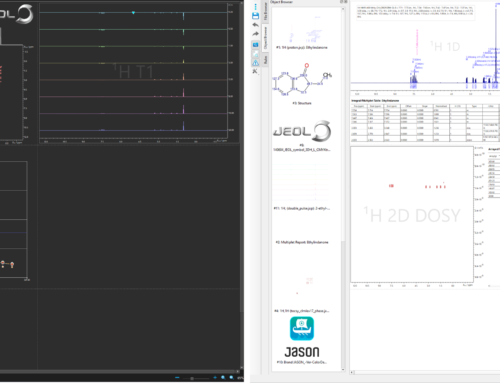Pure shift proton NMR spectra can provide up to an order of magnitude gain in spectral resolution compared to conventional proton spectra. Unfortunately, the “chunked acquisition” approach that is used in many pure shift experiments to speed up the acquisition times usually leads to small periodic artefacts in the baselines of pure shift spectra. While usually not a problem for samples with a relatively small dynamic range (e.g. a pure sample), the artefacts can be an issue when analyzing samples that have low-level impurities (say, a few percent) because the artefacts can obscure real signals or be even misinterpreted as real signals. Figure 1 shows a Zangger-Sterk (ZS) pure shift spectrum of a sample containing a mixture of quinine and camphene, where the relative concentration of camphene is around one percent. As the spectrum shows, there are many small artefact signals spread across the baseline and it is difficult, if not impossible, to distinguish some artefact signals from real ones from the camphene.

Figure 1. Pure shift ZS spectrum of a mixture of quinine and camphene
SAPPHIRE
The SAPPHIRE (Sideband Averaging by Periodic PHase Incrementation of Residual J Evolution) method was developed to greatly reduce the “chunking artefact” problem. I will not go into the exact details of how the SAPPHIRE method works here, but interested readers should check out the original paper by Moutzouri and coworkers. The basic idea is that the phase of the chunking artefacts in the spectrum depends on when exactly in the chunk the J-couplings are refocused. The SAPPHIRE approach consists of collecting several pure shift experiments where various delays in the pulse sequence are adjusted to cause the J-refocussing, and hence the phase of the artefacts, to vary from experiment to experiment. The spectra resulting from the different SAPPHIRE experiments are then added and the artefacts are largely cancelled. It is typical to run either four or eight separate SAPPHIRE experiments (“SAPPHIRE steps”), depending on the sample and artefact suppression requirements.
SAPPHIRE processing in JASON
SAPPHIRE data require special processing because different proportions of the first data chunk from each SAPPHIRE experiment are retained, depending on which SAPPHIRE experiment is being run. JASON already has dedicated tools built into it to process SAPPHIRE data correctly to give ultra-clean pure shift spectra. To illustrate the power of SAPPHIRE combined with JASON processing, below is a comparison of an eight-step ZS SAPPHIRE spectrum of the quinine/camphene mixture with the conventional ZS spectrum. Also for reference is a ZS pure shift spectrum of a pure camphene sample. The data were collected on a JEOL ECZ500R spectrometer equipped with a ROYALHFX probe.

Figure 2. Comparison of region of the standard ZS pure shift spectrum with a SAPPHIRE spectrum
As you can see, the artefacts are all but absent in the SAPPHIRE spectrum, allowing the low-level signals from the camphene to be observed.
To find out more about the SAPPHIRE experiment and processing SAPPHIRE data in JASON, let us know!


